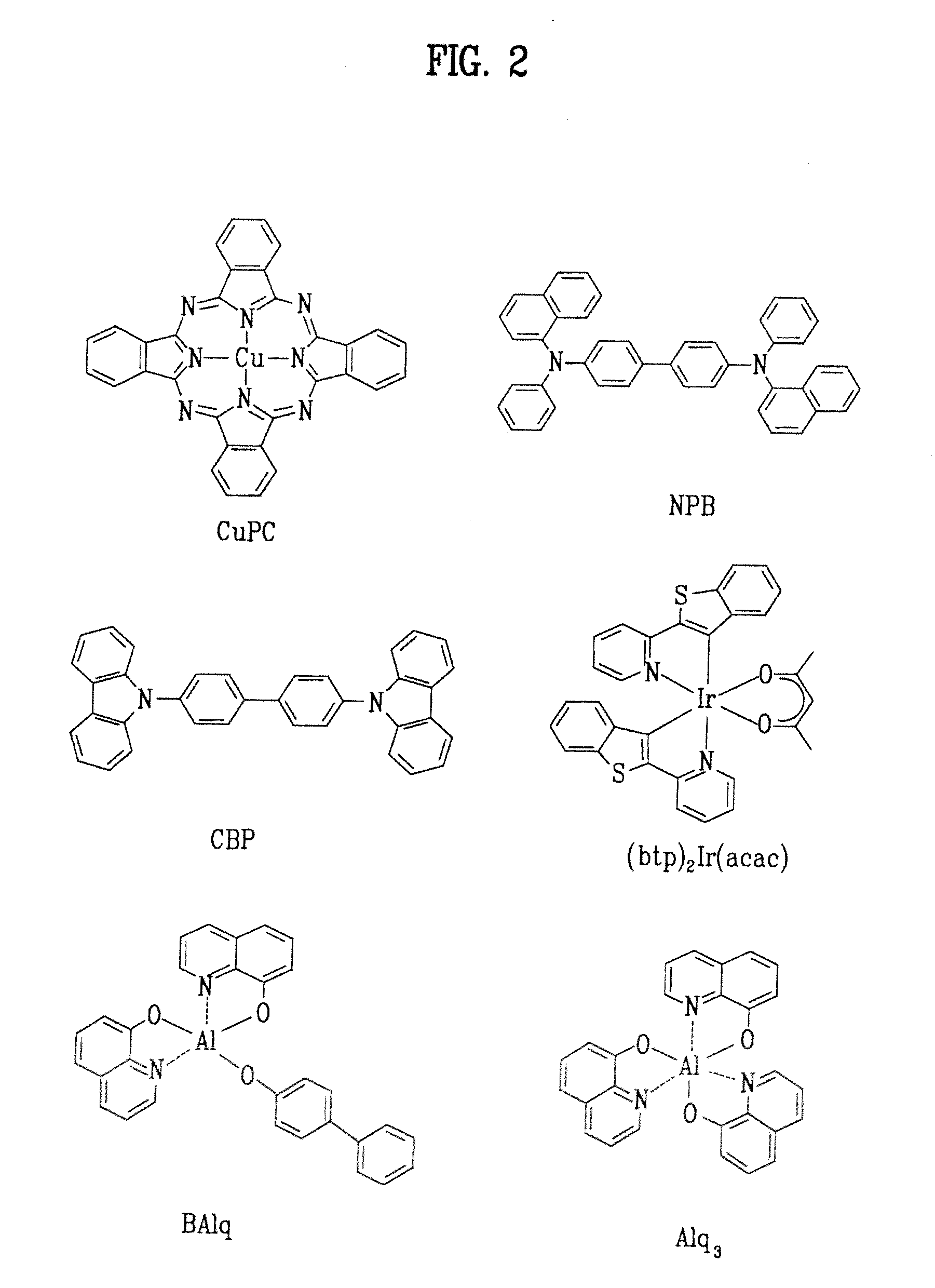Red phosphorescent compound and organic electroluminescent device using the same
a technology of organic electroluminescent devices and phosphorescent compounds, which is applied in the direction of discharge tube luminescnet screens, platinum group organic compounds, other domestic articles, etc., can solve the problems of difficult to achieve external quantum efficiency comparable to internal quantum efficiency, reduce the relative spectral sensitivity of organic el devices, etc., and achieve high luminescence efficiency , long luminescence lifetime, high color purity
- Summary
- Abstract
- Description
- Claims
- Application Information
AI Technical Summary
Benefits of technology
Problems solved by technology
Method used
Image
Examples
first embodiment
[0051]A first embodiment of the present invention provides a red phosphorescent compound represented by Formula 1 below:
[0052]wherein
[0053]wherein R1, R2, R3 and R4 may be each independently selected from substituted or unsubstituted C1-C6 alkyl, substituted or unsubstituted C1-C6 alkoxy, and combinations thereof, in which at least two of R1, R2, R3 and R4 may be C1-C6 alkyl or C1-C6 alkoxy;[0054]in which the C1-C6 alkyl may be selected from the group consisting of methyl, ethyl, n-propyl, i-propyl, n-butyl, i-butyl and t-butyl, and the C1-C6 alkoxy may be selected from the group consisting of methoxy, ethoxy, n-propoxy, i-propoxy, n-butoxy, i-butoxy and t-butoxy; and
[0055]R1, R2, R3 and R4 may be selected from a substituted or unsubstituted halogen, including F, Cl and Br.
[0056]In Formula 1,
is selected from the group consisting of 2,4-pentanedione
2,2,6,6,-teteramethylheptane-3,5-dione
1,3-propanedione
[0057]1,3-butanedione
3,5-heptanedione
1,1,1-trifluoro-2,4-pentanedione
[0058]1,1,1,5,...
second embodiment
[0100]A detailed description of the red phosphorescent compound according to the second embodiment of the present invention will be given below.
[0101]In the second embodiment, provided is a red phosphorescent compound that exhibits improved color purity by substituting phenyl with at least one alkyl, and at the same time, exhibits high luminescence efficiency and long luminescence lifetime by substituting nitrogen-free phenyl of the quinoline with at least two of alkyl and alkoxy.
[0102]The red phosphorescent compound of the second embodiment is also represented by Formula 1 as above.
[0103]However, in the second embodiment,
in Formula 1 is
[0104]
[0105]wherein R1, R2, R3 and R4 may be each independently selected from hydrogen, C1-C6 alkyl and C1-C4 alkoxy, in which at least one of R1, R2, R3 and R4 may be C1-C6 alkyl; and
[0106]R5, R6 and R7 may be each independently selected from hydrogen, C1-C6 alkyl, C1-C4 alkoxy, and combinations thereof, in which at least two of R5, R6 and R7 may be...
synthesis example
(1) Synthesis of 2-(1-methylphenyl)-6-dimethylquinoline
[0120]
[0121]3-methylphenyl borate (13 mmol), 2-chloro-5,7-dimethylquinoline (10 mmol), tetrakis(triphenylphosphine)palladium(0)(0.5 mmol) and potassium carbonate (15 g) are dissolved in tetrahydrofuran (30 ml) and distilled water (10 ml) in a dried two-neck round bottom flask and then stirred at about 100° C. for about 24 hours. After completion of the reaction, the tetrahydrofuran and toluene are removed.
[0122]Subsequently, the reaction mixture is extracted with dichloromethane and water, distilled under reduced pressure and purified by silica gel column chromatography.
[0123]Then, the solvents are distilled under reduced pressure and recrystallized with dichloromethane and petroleum ether. The resulting solid is filtered to yield the target compound, 2-(3-methylphenyl)-5,7-dimethylquinoline (1.9 g).
(2) Synthesis of Chloro-Crosslinked Dimer Complex
[0124]
[0125]Iridium (III) chloride (5 mmol) and 2-(3-methylphenyl)-5,7-dimethylqui...
PUM
 Login to View More
Login to View More Abstract
Description
Claims
Application Information
 Login to View More
Login to View More - R&D
- Intellectual Property
- Life Sciences
- Materials
- Tech Scout
- Unparalleled Data Quality
- Higher Quality Content
- 60% Fewer Hallucinations
Browse by: Latest US Patents, China's latest patents, Technical Efficacy Thesaurus, Application Domain, Technology Topic, Popular Technical Reports.
© 2025 PatSnap. All rights reserved.Legal|Privacy policy|Modern Slavery Act Transparency Statement|Sitemap|About US| Contact US: help@patsnap.com



